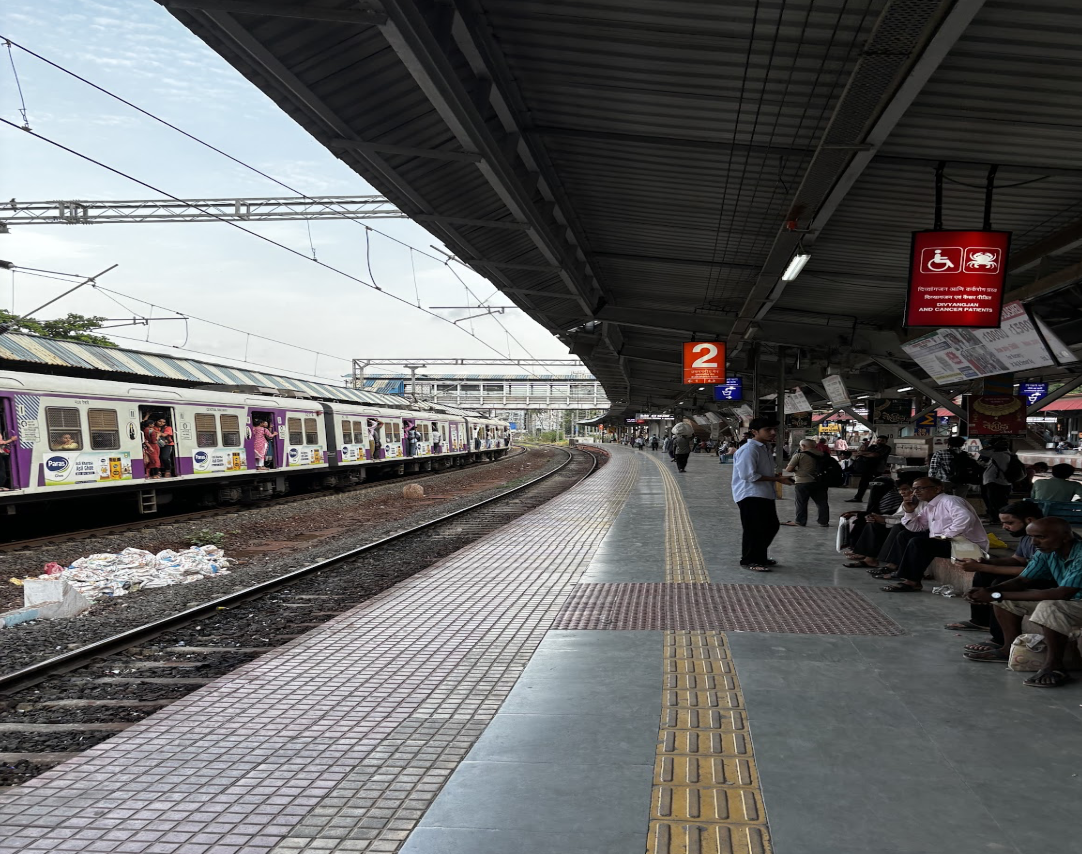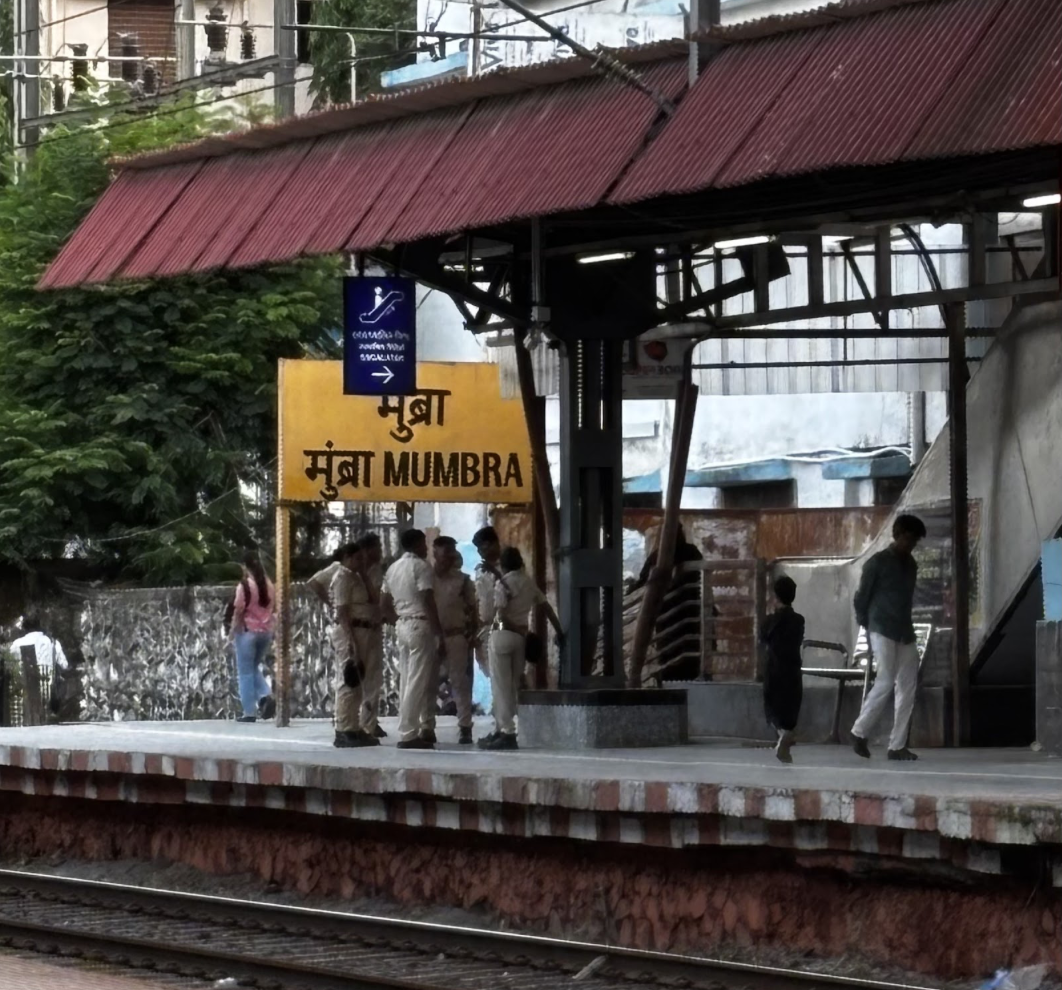Mumbra Train Accident Exposes Underlying Issues Beyond Overcrowding
Mumbra: An accident occurred on the down-fast line near the Mumbra railway station in Maharashtra where passengers fell out of two moving trains, leading to the death of four and injuries to nine others.
According to Swapnil Nila, the public relations officer of Central Railway, the incident took place around 9:30 AM between Mumbra and Diva stations on the Mumbai suburban railway network. Two trains – one heading towards Kasara and the other towards Chhatrapati Shivaji Maharaj Terminus (CSMT) were passing in the opposite direction, when the bags of commuters standing on the footboards of the trains brushed against each other, leading to a fall on the tracks.
Although the Central Railway has set up a five-member committee to probe the exact cause of the accident, overcrowding and a sharp curve at the Mumbra-Diva segment are believed to be the reason behind the tragedy.
A daily commuter from Mumbra, who was at the Mumbra station that day, tells The Wire, “I got on the train that day, it was overcrowded, the CSMT train always is during peak hours. People hanging by the door due to crowding is nothing new. Even after the accident, people were forced to hang by the door”
A deadly curve
A host of activists and commuters are alleging that the accident was due to the existence of a sharp curve in the Kalwa-Mumbra-Diva section. An article in mid-day highlights how the sharp curve caused trains to tilt in this section. “There are two major curves: one at the north approach of Mumbra station and another right at the station itself on the new rail lines,” says Nazim Ansari, vice president of the Mumbra Pravasi Sangh.

The curve at Mumbra station. Photo: Tamoghna Chakraborty
This curve was also confirmed to The Wire by a daily commuter from Mumbra as being “deadly”.
“Whenever you enter Kalwa, the train starts to tilt at a curve. It is so sharp from Mumbra onwards that it feels like you will fall out if you don’t hold on tightly,” they said.
Mumbai Rail Pravasi Sangh also claimed that they had complained about the curve to the railway board previously, but no action has been taken.

Considerable police deployment at Mumbra station. Photo: Tamoghna Chakraborty
Overcrowding
Over the last year, at least seven people have died everyday while travelling on the Mumbai local. Authorities have concluded overcrowding as the reason behind it.
Although overcrowding of local trains affects the safety and livelihoods of commuters, especially those commuting from suburban areas in the north of the city to the south for work, there are deeper reasons as to why the accidents have become so frequent.
“Overcrowding has always been there, but it is not being managed properly,” says Abhijeet Dhurat, the president of Mumbai Rail Pravasi Mahasangh in an interview to The Wire. He adds, “In the peak hours of the day the crowd is north to south bound in the morning and the opposite direction in the evening, the railways know this and still run mail trains on local lines in peak hours, which leads to staggered number of trains and excessive crowding in the trains that do come during these hours.”
Debates on AC trains
The government has been pushing to introduce more air-conditioned trains in the last few years as a solution to the overcrowding and accidents. Even in the aftermath of the Mumbra incident, Maharashtra chief minister Devendra Fadnavis announced that the number of AC trains will be increased without an increase in the fare. However, activists and commuters feel that more AC trains will only worsen the situation rather than alleviating it.
Abhijeet Dhurat says, “The fare of AC trains is already high, working class people rarely use those and even if people use them, the maximum capacity is 2,000-3,000. But in normal trains, firstly, the fare is Rs 10 and it can fit 5,000-6,000 people when it gets too crowded. AC trains during peak hours only alleviate the crowds in the non-AC ones coming before and after them”
Sudheesh Pillai, another daily commuter who travels 1 hour 30 mins everyday from Kandivali to Chembur adds to this, “the problem with ac locals has been that it replaced non-AC, it isn’t an extra train added. During peak time, it's an annoying thing as there'll be one overcrowded train that you let go, and then the next one would be an ac one and then a ladies train (I can't even imagine a woman's experience in local train) and then a non ac comes but it's again overcrowded. If you don't have two or three consecutive trains running, it'll inevitably be crowded because the number of people just piles up and then eventually they rush and try to get in no matter what the next train is.”
Overcrowding is not the only issue that’s plaguing Mumbai's local trains. Commuters complain about trains being late, incorrect indicators, last minute platform changes, trains not stopping at certain stations, and such
Activists like Mr. Dhurat have also for years been petitioning the railways to increase 5th and 6th line- which are reserved for local trains in the central line- beyond Kalyan, till Kasara and Karjat. They feel there's a sort of neglect for the central line and overall suburban sectors by the railway.
Deeper socio-economic issues
Although overcrowding seems like the biggest commuting issue, there are deeper socio-economic reasons as to why a crowd of millions of people are forced to travel from the suburbs to the south and centre of the city everyday for work.
A study revealed that employment opportunities in Mumbai's South Dadar, Worli, Prabhadevi, etc and West Bandra, Andheri, Juhu, etc, localities are higher paying than any of the suburban areas like Dahanu, Bhayandar, Thane, Mumbra and such. However, the cost of living in the south and west areas is much higher compared to the suburbs, or Mumbai Metropolitan Region (MMR). Thus, it is almost impossible for a working class family to sustain a decent standard of living in the city with the average salary. It forces people to move to cheaper suburbs, and on the other hand, the concentration of high paying jobs in the city “centre” and lack of the same in suburbs forces them to commute great distances for work.
Mohsin Khan, a resident of Diva and a jewellery shop manager in Prabhadevi, describes his daily commute as exhausting. “Every morning, I take a shared auto to the station, then wait for a train that's usually late, overcrowded, too costly if it's AC, or sometimes just cancelled. All this makes me late and costs me in salary cuts,” he says. To avoid this, he now leaves by 6 AM to reach work by 9 AM.
He chose the distant job for its higher pay five years ago. Despite the challenges, Mohsin says there’s “no possibility” of moving closer – even if he earns “double the salary for 10 years.”
Sudheesh Pillai, who is also a social science student, says that it is “cruel” that most suburban residents have to commute so far for education and employment. He adds, “That's how this city is made, where they take labour from the suburbs. People from Virar, Nalasopara, Borivali travel to Bandra, Dadar, Prabhadevi and Churchgate for work and studies.”
He also believes that the development pattern in Mumbai and MMR has been skewed as a whole. The government is constructing more coastal roads and metros in the south and central localities, it hardly helps the working class population from the north and east areas.
Considering public transport is not allowed on these roads, it begs the question: who are the roads even benefiting?
Dhurat says that there has been a complete “failure” of successive governments since decades to develop the rapidly expanding suburbs. He raises the question that if the majority of the workers come from the greater MMR region, why does the government not expand at least some government offices to these regions?
Accidents like the one at Mumbra station have become a commonstay in Mumbai locals – to the fact that it bothers neither the authorities nor the commuters in the long run. Despite numerous petitions and demands to reform the railways, nothing has changed.
Moreover, such accidents are brushed off as lone incidents and daily commute issues but it is important to ask why such horrid situations occur in the first place which cause loss of life.
Discussions about skewed development favouring a certain class of population and exploiting labour of the working class arise when we look at issues of daily commute at a deeper level. Who benefits from the highways, coastal roads and metros and who suffers from the continued despair of the railways is something which should be discussed.
Tamoghna Chakraborty is a reporting intern at The Wire.
This article went live on June thirteenth, two thousand twenty five, at thirteen minutes past two in the afternoon.The Wire is now on WhatsApp. Follow our channel for sharp analysis and opinions on the latest developments.




